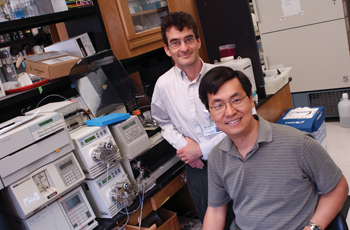
Daniel Kurnik, M.D., left, and Richard Kim, M.D., are studying ways to deliver drugs across the blood-brain barrier.
Photo by Dana Johnson
No easy access for drug entry into brain
Once sequestered behind the blood-brain barrier, tumors and viruses are often untouchable to many drugs that would be used against them.
For years, scientists have been trying to find ways to breach the barrier and deliver drugs to this well-protected site.
In a recent study, Vanderbilt University Medical Center researchers showed that inhibiting certain molecular components of the blood-brain barrier improved entry of a drug into the brains of mice. However, the dose of inhibitor required may prove unsafe to use in humans, suggesting that delivering drugs to the brain will be no easy feat.
The study, led by Grant Wilkinson, Ph.D., D.Sc., professor of Pharmacology, appears online in the Journal of Pharmacology and Experimental Therapeutics.
The molecular pumps, or transporters, of the blood-brain barrier act more like bilge pumps than a barricade, pumping out potentially toxic molecules that try to enter the brain.
These transporters likely arose very early in the tree of life to protect organisms against dangerous environmental chemicals. P-glycoprotein (Pgp), one of the major transporters of the blood-brain barrier, can transport a wide variety of structurally unrelated compounds back into the bloodstream, offering broad-spectrum protection against environmental toxins. Unfortunately, it does the same for many therapeutic drugs.
“Some drugs could be potentially useful if only they could get into the brain,” said Richard Kim, M.D., professor of Medicine and Pharmacology and co-author on the study. “Presumably there are certain cancer drugs that would have efficacy against brain tumors, but they are never used that way because they can't get there.”
Several years ago, researchers developed drugs that inhibit Pgp in hopes of enhancing drug delivery to tumors, particularly those that had developed resistance to chemotherapy. These inhibitors did increase the amount of chemotherapy reaching tumors, but healthy tissues were also affected, resulting in unacceptable toxicity.
Whether Pgp inhibition could be achieved in specific tissues without toxicity has remained unclear. In their current study, Wilkinson and colleagues investigated the dosage of Pgp inhibitors tariquidar and elacridar required to aid delivery of the opiate drug loperamide to the brain, testes and certain white blood cells (lymphocytes) in mice.
Although similar to morphine, loperamide normally has no pain-relieving effects because Pgp prevents the drug from entering the brain. Mice given the Pgp inhibitors along with loperamide took longer to raise a paw from a hot plate than mice not given Pgp inhibitors, an indication of decreased pain sensitivity. This effect occurred rapidly after loperamide was administered (within five minutes) and lasted for several hours. The results indicated that the loperamide was quickly entering and acting in the brain.
The researchers then measured loperamide concentrations in the three tissues.
“Basically, the idea was to give increasing doses of Pgp inhibitors followed by a standard dose of loperamide to see if there were differences among tissues in their susceptibility to Pgp inhibition,” said Daniel Kurnik, M.D., a research fellow and co-author on the study.
They found that both types of Pgp inhibitors examined increased loperamide concentrations in all tissues. However, a higher dose of inhibitor was required to get the drug to the brain compared to the other tissues.
Lymphocytes were the most sensitive, requiring the lowest concentrations of inhibitors.
The results provide a 'proof-of-principle,' demonstrating that Pgp inhibition can greatly increase drug delivery to the brain, but the high doses required suggest that brain Pgp is somehow different than Pgp in peripheral tissues. Whether such high doses could be safely used in humans remains an unanswered question.
“It also makes us ponder or at least pause a little bit about the feasibility of clinically meaningful inhibition of Pgp in humans, at least from the point of view of drug entry into the brain,” Kim said.
“It suggests to us that it may be a little harder than we think.”
Other Vanderbilt authors included: Alastair Wood, M.B., Ch.B., Edna Choo, Mordechai Muszkat, Tadashi Ohkubo, Sheila Shay, James Higginbotham and Hartmut Glaeser.
The research was supported by grants from the U.S. Public Health Service and Merck, Sharp and Dohme International Fellowships in Clinical Pharmacology.













